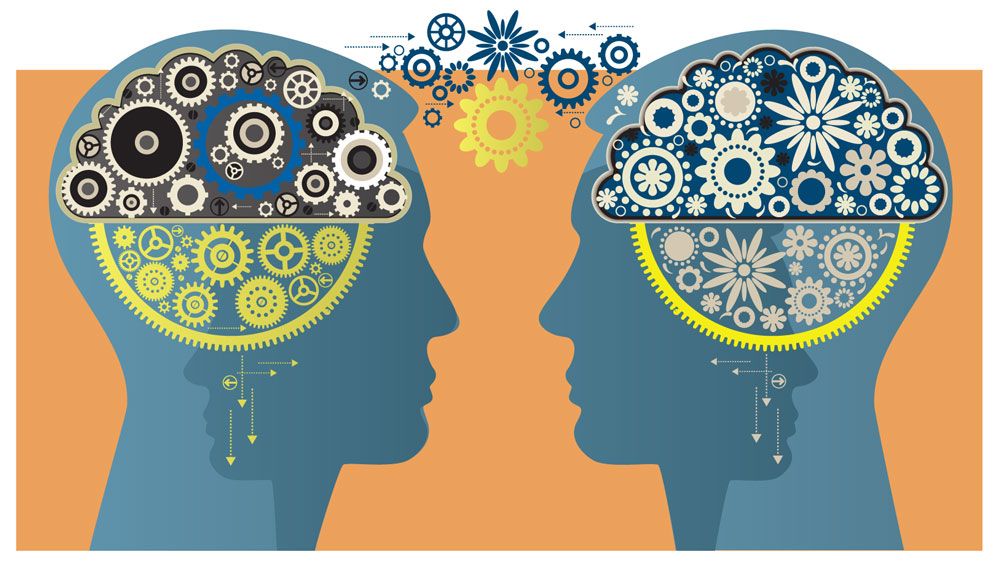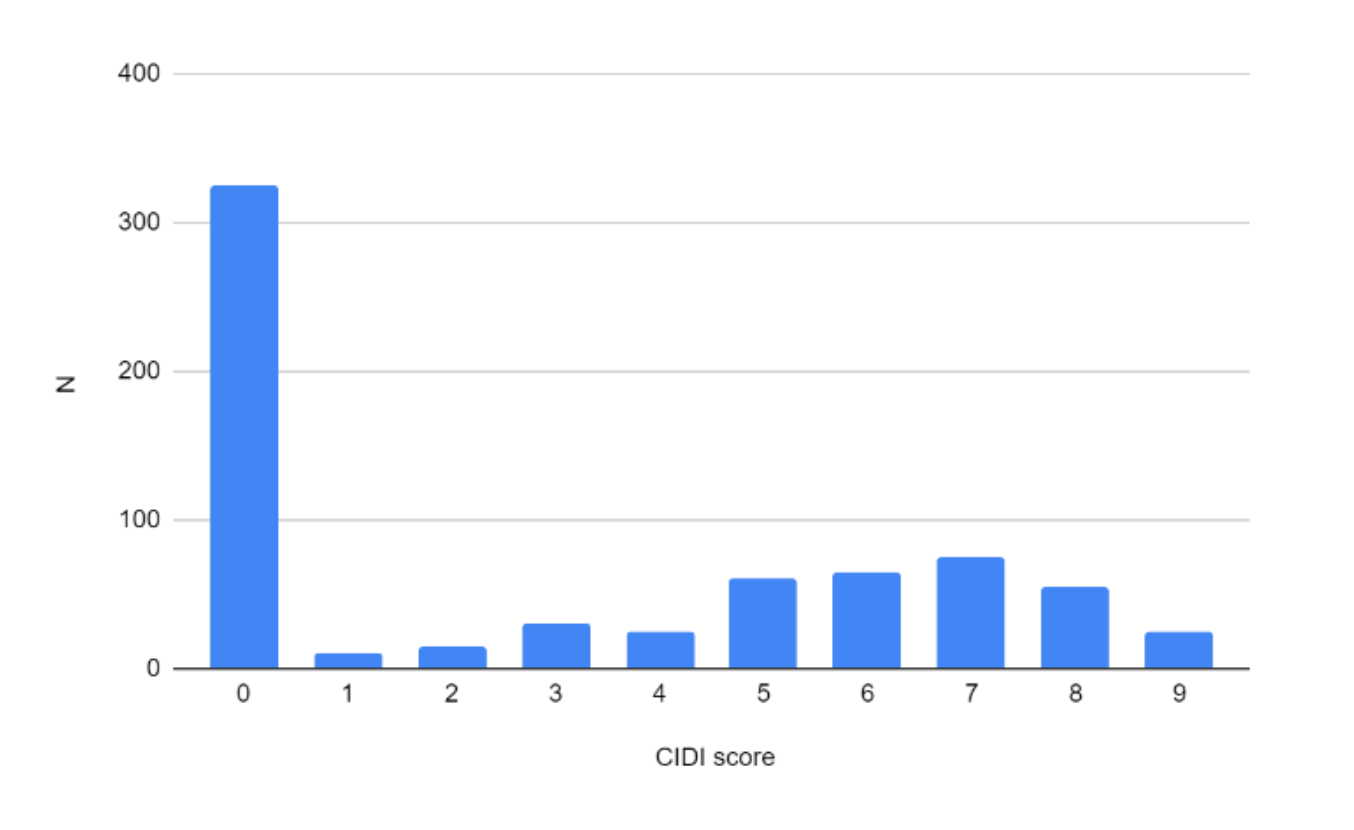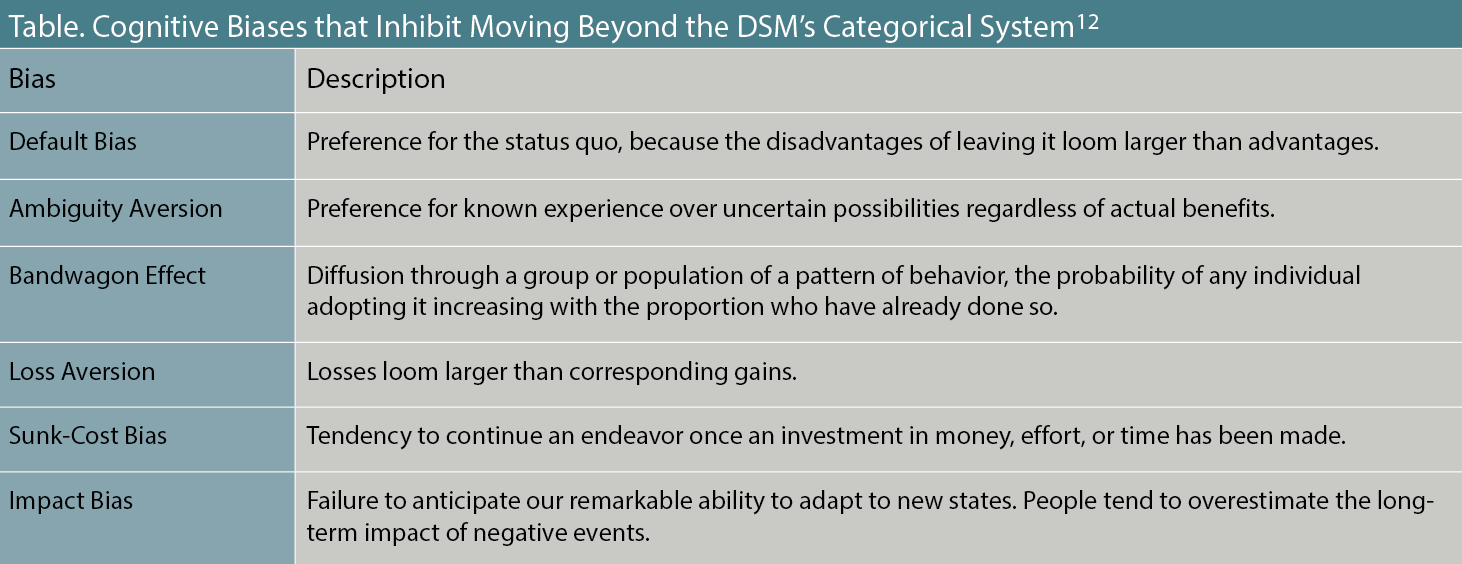See Part 2
Depression/Anxiety: Dimensional Treatment Decisions
James Phelps, MD
Article
Author(s):
Exploring cognitive biases toward the DSM and their avoidable effects on treatment decisions.
VLADGRIN/Adobe Stock

CLINICAL REFLECTIONS
(This is the first of a 2-part series. The next article will discuss the spectrum nature of treatment decisions and how this can improve the process of shared decision-making with patients—Ed.)
Bipolar disorder (BD) is a categorical diagnosis according to the DSM—yes or no; present or not. But bipolarity is increasingly recognized to be a spectrum phenomenon that warrants dimensional diagnosis—eg, per the chairman of the DSM-5,1 mood epidemiologists,2 and sharp clinicians.3
Depression/Anxiety: Dimensional Treatment Decisions
James Phelps, MD
Instead of asking if the patient has bipolar disorder, the head of the STEP-BD research program suggested in 2005 that we should ask, “How bipolar is this patient?”4 Why then are we still using the DSM as though it were the only way to think diagnostically? Here is 1 reason: categorization bias.
The Figure presents an example of bipolarity as a spectrum phenomenon. It includes structured interview results from 641 primary care patients referred for psychiatric consultation,5 using the CIDI 3.0—a bipolar assessment tool6 from the World Health Organization that has been used in primary care research.7
Figure. Distribution of CIDI Scores Among 700 Primary Care Patients Referred for Psychiatric Consultation

The CIDI asks 2 questions about euphoria and irritability. If either is endorsed, another screening question asks whether this is episodic. If that too is endorsed, the full questionnaire8 is administered, containing additional questions about manic symptoms. The Figure shows the frequency of each score, from 0 to 9.
As you can see, among these patients—who were referred primarily for depression or anxiety problems—most scored 0 on the CIDI. But among the rest of the patients, scores created a bell-shaped curve. In this study, the same phenomenon was seen5 with additional questions about bipolar markers: family history, age of onset of depression, course of illness, and response to previous treatments. All these indicators of bipolarity lie on a spectrum from absent to fully present. There is no step-up—no obvious place to put a categorical diagnostic cut-off (including at 7 yes responses, which is the criterion used in previous research7).
Likewise, in clinical experience, hypomania/mania is also dimensional. Manic symptoms can present at any intensity. Some patients have the full experience, for which DSM criteria work well: That is bipolar I. Some patients have obvious hypomania that is observable to others: That is DSM-level bipolar II. But patients describe myriad variations of “up” symptoms.
If you have seen lots of patients with depression, you will have also observed the subtle forms of hypomania: a little more talkative than usual, a little more flamboyant, enthusiastic, confident. Needing less sleep, more motivated, energized. More willing to spend money. This state can accelerate into overt hypomania or mania, or just subside—or collapse into depression or become admixed with it. There are no cut-offs between such states in clinical experience—nor in patients’ experience. A brilliant example is presented in a newly published memoir, BrainStorm: From Broken to Blessed on the Bipolar Spectrum,9 a bipolar II parallel to Kay Jamison, PhD’s, descriptions of the full manic-depressive experience.10
If bipolarity is a dimensional phenomenon, why is the DSM still our primary diagnostic approach to mood disorders? Categorical and dimensional approaches can be used simultaneously,11 but multiple cognitive biases incline psychiatry toward the DSM (Table).12
Table. Cognitive Biases that Inhibit Moving Beyond the DSM’s Categorical System12

The Harvard Business Review recently examined another that is relevant to psychiatric diagnosis: categorization bias.13 (This analysis is replete with examples of the serious costs associated with this bias in the financial world.)
Categorization Bias
According to 2 marketing professors, our natural tendency to draw lines and create categories has 4 downsides:13
1. Compression: One can lose sight of the many variations that exist within the category.
2. Amplification: One can exaggerate differences across category boundaries.
3. Discrimination: One can favor certain categories over others, insufficiently attending to other categories.
4. Fossilization: To quote John Maynard Keynes, “The difficulty lies not in the new ideas, but in escaping from the old ones.”
To these we should add 1 more crucial downside of categorization bias: reification, or the tendency to make a thing out of a label. As Kenneth S. Kendler, MD, a scholar of psychiatric diagnosis, put it, “our field has undergone a ‘conceptual creep’ in which our criteria have mistakenly become our disorder.”14 In his article entitled “The Problem of Reification,” former National Institute of Mental Health (NIMH) Director Steven E. Hyman, MD, suggested that categorization creates “epistemic blinders” that impede progress toward valid diagnoses.15
Cognitive Forcing
An article in the American Medical Association’s Journal of Ethics asserts that, like all humans, health professionals are subject to cognitive biases, and we must recognize the costs of these cognitive biases and the potential benefits of combating them.16 The article cites a clinical decision-making specialist who has suggested using “cognitive forcing” to reduce errors.17 Forcing means conscious consideration of an alternative diagnosis—or, in this context, an alternative diagnostic perspective (eg, dimensional in addition to categorical).
For example, suppose your next patient, Ms Smith, presents with depression, anxiety, and a history of trauma. Posttraumatic stress disorder (PTSD) is an obvious potential diagnosis. Diagnostic forcing would entail consideration of alternative diagnoses, such as major depression with mixed features. Nosologic forcing would invite letting go of distinctions between trauma, mood, and anxiety disorders.
Does this mean “farewell to differential diagnosis,” as one expert lamented18 following a description of the complexity of mixed states?19 Not entirely. One can think both categorically and dimensionally (perhaps not at the same moment):
a) What is the diagnosis? Does the patient meet DSM criteria for PTSD?
and
b) How mixed is this depression? How traumatic was the experience?
Perhaps the latter questions will not help a busy clinician. Aren’t categories better for guiding clinical decisions? As a clinician myself, I strongly disagree, but we can all easily agree that we want what is best for Ms Smith. If it helps her to say yes or no to a diagnosis of PTSD, fine. For example, a formal diagnosis might make it easier to strongly recommend psychotherapy as first-line treatment for PTSD, rather than an antidepressant. On the other hand, if Ms Smith struggles with the label; if her trauma was not profound and she does not have pronounced avoidance and intrusive recall; and if she has a first-degree relative with a clearly established diagnosis of bipolar I—then perhaps then perhaps inviting her to learn more about subthreshold bipolarity and its treatment options is the next step. I created a series of 6 5-minute videos for this purpose.20
In the next segment of this 2-part series on psychiatric diagnosis, I will suggest that treatment decisions lie on a continuum just as psychiatric diagnoses do. Contriving diagnostic cut-offs does not facilitate these decisions—indeed, it can interfere with them. Instead, acknowledging the spectrum nature of treatment decisions can improve the process of shared decision-making with patients. I suspect this is what many of us are really doing even while operating under the DSM roof.
Dr Phelps is research editor at the Psychopharmacology Institute; emeritus faculty at Samaritan Mental Health in Corvallis, Oregon; and founder of PsychEducation.org. He is the bipolar disorder section editor for Psychiatric TimesTM and the author of A Spectrum Approach to Mood Disorders for clinicians and Bipolar, Not So Much for patients and their families.
References
1. Phillips ML, Kupfer DJ. Bipolar disorder diagnosis: challenges and future directions. Lancet. 2013;381(9878):1663-1671.
2. Angst J, Merikangas KR, Cui L, et al. Bipolar spectrum in major depressive disorders. Eur Arch Psychiatry Clin Neurosci. 2018;268(8):741-748.
3. Fogelson DL, Kagan BL. Bipolar spectrum disorder masquerading as treatment resistant unipolar depression. Cambridge University Press. 2020:1-3.
4. Saenger E. The Bipolarity Index as a tool for assessment and creating rapport: an expert interview with Gary Sachs, MD. Medscape Psychiatry & Mental Health. 2005;10(1).
5. Phelps J, Bale J, Squires III K, et al. Bipolarity in a collaborative care model variation: detection, prevalence, and outcomes. Psychiatr Serv. 2020;71(11):1098-1103.
6. Kessler RC, Akiskal HS, Angst J, et al. Validity of the assessment of bipolar spectrum disorders in the WHO CIDI 3.0. J Affect Disord. 2006;96(3):259-269.
7. Cerimele JM, Chan YF, Chwastiak LA, et al. Bipolar disorder in primary care: clinical characteristics of 740 primary care patients with bipolar disorder. Psychiatr Serv. 2014;65(8):1041-1046.
8. CIDI-Based Screening Scale for Bipolar Spectrum Disorders. University of Washington Advancing Integrated Mental Health Solutions Center.
9. Schley S. Brainstorm: From Broken to Blessed on the Bipolar Spectrum. Seed Systems; 2021.
10. Jamison KR. An Unquiet Mind: A Memoir of Moods and Madness. Alfred A. Knopf, Inc.; 1995.
11. Nierenberg AA. Bipolar II disorder is NOT a myth. Can J Psychiatry. 2019;64(8):537-540.
12. The psychiatrist’s list of cognitive biases. Psych Scene. Accessed January 26, 2022. https://psychscene.com/psychiatrists-list-cognitive-biases/
13. de Langhe B, Fernbach P. The dangers of categorical thinking. Harvard Business Review. 2019. Accessed January 26, 2022. https://hbr.org/2019/09/the-dangers-of-categorical-thinking
14. Kendler KS. The phenomenology of major depression and the representativeness and nature of DSM criteria. Am J Psychiatry. 2016;173(8):771-780.
15. Hyman SE. The diagnosis of mental disorders: the problem of reification. Annu Rev Clin Psychol. 2010;6:155-179.
16. Doherty TS, Carroll AE. Believing in overcoming cognitive biases. AMA J Ethics. 2020;22(9):773-778.
17. Croskerry P. The importance of cognitive errors in diagnosis and strategies to minimize them. Acad Med. 2003;78(8):775-780.
18. Goldberg JF. Mixed depression: a farewell to differential diagnosis? J Clin Psychiatry. 2015;76(3).
19. Perugi G, Angst J, Azorin JM, et al. Mixed features in patients with a major depressive episode: the BRIDGE-II-MIX study. J Clin Psychiatry. 2015;76(3):e351-e358.
20. Phelps J. What kind of depression do you have? a video series. PsychEducation. https://www.youtube.com/playlist?list=PL1lTWq-FqdPIBYwhJb8j5NCMMTg0lxTVI